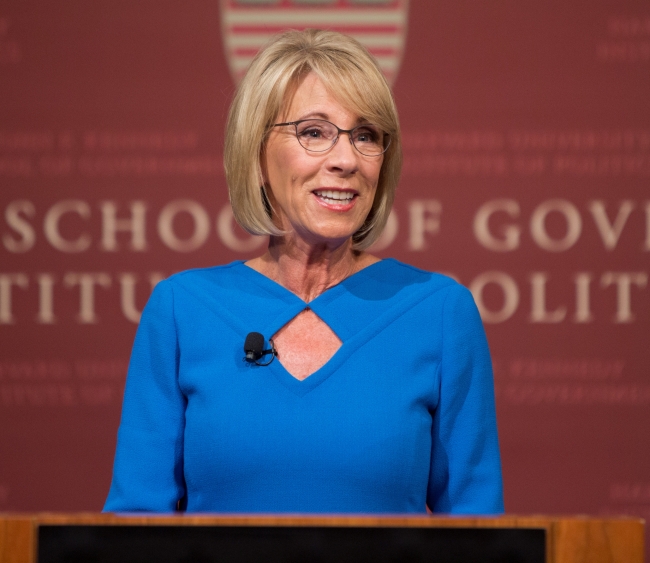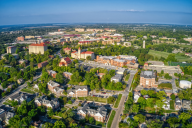You have /5 articles left.
Sign up for a free account or log in.

Education Secretary Betsy DeVos
Getty Images
The Trump administration's higher education policy to date has consisted largely of undoing what it inherited -- rolling back, for instance, ambitious Obama era regulations on for-profit colleges and campus policies on sexual assault. Observers looking for an affirmative, forward-looking agenda have been hard-pressed to find much so far.
But Education Secretary Betsy DeVos this month provided as a clear a sense as observers have yet seen of her vision for her department's role in, and agenda for, postsecondary education, with a set of comments signaling a shift in emphasis from education to training.
In two separate forums this month, she said students have for years received a message that "the only path for a successful life" is through a four-year degree. But the increasing diversity of the student population -- and the relatively small proportion of students enrolled full-time at four-year institutions -- points to the need for greater attention to alternatives involving skills training, she said.
"To a large extent, we have stigmatized them for the past couple of decades," DeVos said of skills-training programs. "We have a lot of students who would benefit from being exposed to those different options."
DeVos's comments are in many ways consistent with statements President Trump has made since the election, and they double down on early efforts in his administration to elevate apprenticeships as a way to prepare workers.
But to the extent that her statements signal a broader philosophical approach to higher education, the implications could be significant, especially if the administration aggressively embraces her rhetoric in its policy decisions.
Some community college officials said they welcome the emphasis on work-force training, since two-year institutions would by necessity play a large role in any ambitious expansion of apprenticeship or other job preparation programs. But other leaders in the sector expressed concern that the secretary's rhetoric ignores the extent to which most skills training is embedded into a broader general education context, at two-year and four-year colleges alike.
Other policy experts said they believed DeVos's comments caricatured the extent to which the Obama administration's college attainment push focused on four-year colleges, and that an aggressive push in this direction could serve to discourage students from attending college, which remains the most promising path to entering the middle class.
Ambitious Vision of Previous Administration
President Obama made higher education a clear priority in his first speech to Congress by outlining a lofty goal for degree attainment. By 2020, he said, the United States should have the highest proportion of college-educated adults of any country. The U.S. looks to be falling well short of that goal, but higher ed advocates called it the strongest statement yet by a president in support of postsecondary education.
Obama's campaign in support of that ambitious vision also acknowledged that many different pathways to a post-high school education should be appropriate, including community colleges and vocational training as well as four-year institutions. And his administration followed through by making major investments in community college, including a $2 billion infusion for community colleges via the Trade Adjustment Assistance Community College and Career Training grant program in 2010. He also forcefully backed efforts at the state level to make two-year colleges completely tuition-free.
Complaints still arose, however, over what some saw as a bias toward traditional colleges in the president's message. DeVos's comments this month appeared to echo those critics of the previous administration. And her rhetoric places a much more explicit emphasis on the role of vocational and career training.
“Many students graduate high school and don’t know what they want to pursue,” she said this month at a Wall Street Journal CEO Council event. “We have to give students a much wider venue of opportunities starting in high school and middle school to help guide them into a productive future.”
The attention from the Trump administration to work-force training programs is welcome news for community colleges.
"Our members are cheered to see the recognition that those comments reflected," said David Baime, senior vice president for government relations and policy analysis at the American Association of Community Colleges.
Baime noted that DeVos's comments were in line with previous promises from the Trump administration to create 4.5 million new apprenticeships in five years. President Trump also called for a $200 million grant program to fund training in high-growth sectors -- although an earlier White House budget proposal slashed existing work-force training.
Kermit Kaleba, federal policy director at the National Skills Coalition, said he agreed with the notion that federal policy has overemphasized a traditional college education.
"As a general rule, federal policy has tended to focus pretty exclusively on access to four-year diplomas, and there's been a lot less emphasis on shorter-term educational training pathways," he said. "We spend about $30 billion a year on Pell Grants. We spend less than a 10th of that on work-force training."
Kaleba called the $2 billion in additional funding for community colleges under Obama a significant investment. But the coalition would also like to see policies allowing use of Pell Grants for short-term programs -- an idea that's gained momentum on both sides of the aisle in Washington -- as well as more "stackable" credentials.
DeVos, in her comments, called for better coordination between colleges and local business and industry about work-force needs. Many community colleges will be quick to say, however, that much of that work is already happening at the local level.
Greg Hamann, president of Linn-Benton Community College, in Oregon, said his college works closely with businesses in the area to provide graduates with the kinds of skills they're seeking. That makes community colleges well positioned to do a great deal of the work DeVos is talking up, he said.
But Hamann said the secretary's comments this month may be interpreted as promoting apprenticeships and work-force training at the expense of a broader education based on a college campus. He said specific skills-training programs at his college are designed to give students a broad knowledge of critical thinking and problem solving for the workplace.
"You probably won't be spending the rest of your life where your only interaction is between you and a piece of pipe," he said. "You'll be interacting with people. You'll have to navigate a work environment that's constantly changing."
Others worry that the rhetoric from DeVos signals that she will be less interested than previous education leaders in promoting to all students the possibility of a four-year degree.
Andrew Nichols, director of higher education research and data analytics at the Education Trust, said it is "kind of a dangerous message" to suggest that a four-year degree has been overvalued. A bachelor's degree is still the most reliable pathway to the middle class, he said.
Recent research from Georgetown University's Center on Education and the Workforce confirmed that a bachelor's degree is the "gold standard" for obtaining a well-paying job. College graduates held an increasing share of those jobs over the last quarter century, the Georgetown study found.
Traditional four-year institutions, meanwhile, still have serious work ahead of them to address issues with access on their campuses for traditionally underserved student populations.
"My main question to Secretary DeVos would be what are they doing to make sure apprenticeships or career tech programs aren't options that disproportionately appeal to low-income black and Latino students just because they've been systematically disadvantaged in various aspects of society," Nichols said.
While DeVos's comments didn't specify what kind of investment of resources she hoped to see in career and technical education versus apprenticeships, and indeed tended to lump them together, there are significant differences between those training options.
Career and technical education, commonly known as vocational education, has struggled for decades to overcome a well-earned reputation for tracking low-income and minority students into dead-end programs, said Mary Alice McCarthy, director of the Center on Education and Skills at New America. That said, career and technical programs have made great strides, particularly over the last decade, in improving the quality of their offerings, she said.
The Georgetown Center on Education and the Workforce has found that certificates are the fastest-growing postsecondary credential. But women who hold certificates are generally clustered in health-care fields that pay less than professions where men with certificates tend to find work. Georgetown also found that a third of certificate holders also hold an associate, bachelor's or graduate degree, suggesting that many workers are getting those credentials to add skills in a tight job market.
The challenge for apprenticeships is not a stigma, McCarthy said -- a recent New America survey showed they are as popular with the public as four-year universities and community colleges -- but the reality that there are few programs available and they are concentrated in a small number of fields, like skilled trades and manufacturing. The number of current registered apprenticeships is around 500,000.
"It's a tiny, tiny system and it has very weak connections to postsecondary degrees, which also limits its growth," she said.
At least one veteran of the Obama White House saw in the secretary's comments a continuation of Obama's support for community colleges. James Kvaal, who last month was named president of the Institute for College Access and Success, said DeVos appeared to recognize the critical role of community colleges in fueling growth in the number of higher ed graduates. He said Obama's 2009 goals recognized that the bulk of new college graduates required to meet his goal would have to come from community colleges.
"That was the driving force behind his proposal to make community colleges free and his belief that these institutions are important to building the size and influence of the middle class," Kvaal said.








